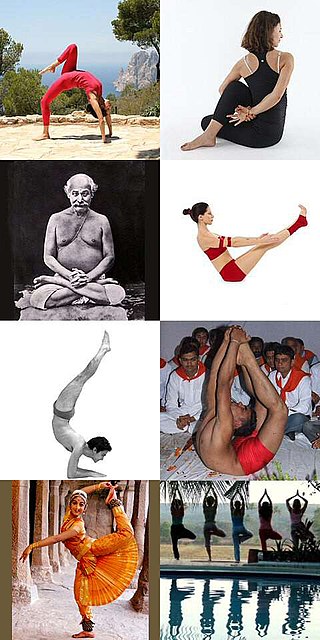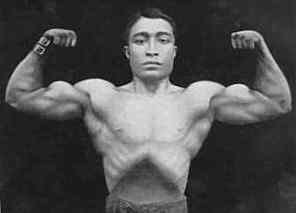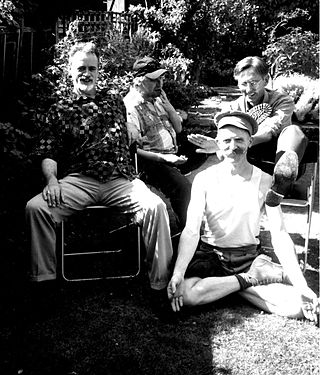
An āsana is a body posture, originally and still a general term for a sitting meditation pose, and later extended in hatha yoga and modern yoga as exercise, to any type of position, adding reclining, standing, inverted, twisting, and balancing poses. The Yoga Sutras of Patanjali define "asana" as "[a position that] is steady and comfortable". Patanjali mentions the ability to sit for extended periods as one of the eight limbs of his system. Asanas are also called yoga poses or yoga postures in English.

Sivananda Saraswati was a yoga guru, a Hindu spiritual teacher, and a proponent of Vedanta. Sivananda was born in Pattamadai, in the Tirunelveli district of Tamil Nadu, and was named Kuppuswami. He studied medicine and served in British Malaya as a physician for several years before taking up monasticism.

Sun Salutation, also called Surya Namaskar(a) or Salute to the Sun (Sanskrit: सूर्यनमस्कार, romanized: Sūryanamaskāra), is a practice in yoga as exercise incorporating a flow sequence of some twelve linked asanas. The asana sequence was first recorded as yoga in the early 20th century, though similar exercises were in use in India before that, for example among wrestlers. The basic sequence involves moving from a standing position into Downward and Upward Dog poses and then back to the standing position, but many variations are possible. The set of 12 asanas is dedicated to the Hindu solar deity, Surya. In some Indian traditions, the positions are each associated with a different mantra.

Satyananda Saraswati, was a Sanyasi, yoga teacher and guru in both his native India and the West. He was a student of Sivananda Saraswati, the founder of the Divine Life Society, and founded the Bihar School of Yoga in 1964. He wrote over 80 books, including the popular 1969 manual Asana Pranayama Mudra Bandha.

The Divine Life Society (DLS) is a Hindu spiritual organization and an ashram, founded by Swami Sivananda Saraswati in 1936, at Muni Ki Reti, Rishikesh, India. Today Divine Life Society has branches around the world, with the headquarters situated in Rishikesh. Many disciples of Swami Sivananda have started independent organizations in Mauritius, the United States, Australia, Canada, Malaysia, South Africa, South America, and Europe.

Vishnudevananda Saraswati was an Indian yoga guru known for his teaching of asanas, a disciple of Sivananda Saraswati, and founder of the International Sivananda Yoga Vedanta Centres and Ashrams. He established the Sivananda Yoga Teachers' Training Course, possibly the first yoga teacher training programs in the West. His books The Complete Illustrated Book of Yoga (1960) and Meditation and Mantras (1978) established him as an authority on Hatha and Raja yoga. Vishnudevananda was a peace activist who rode in several "peace flights" over places of conflict, including the Berlin Wall prior to German reunification.

Sivananda Yoga is a spiritual yoga system founded by Vishnudevananda; it includes the use of asanas but is not limited to them as in systems of yoga as exercise. He named this system, as well as the international Sivananda Yoga Vedanta Centres organization responsible for propagating its teachings, after his guru, Sivananda with the mission 'to spread the teachings of yoga and the message of world peace' which has since been refined to 'practice and teach the ancient yogic knowledge for health, peace, unity in diversity and self-realization.'

The Complete Illustrated Book of Yoga is a bestselling 1960 book by Swami Vishnudevananda, the founder of the Sivananda Yoga Vedanta Centres. It is an introduction to Hatha yoga, describing the Yoga Sutras of Patanjali and the Hatha Yoga Pradipika. It contributed to the incorporation of Surya Namaskar into yoga as exercise. While some of its subject matter is the traditional philosophy of yoga, its detailed photographs of Vishnudevananda performing the asanas is modern, helping to market the Sivananda yoga brand to a global audience.

Bakasana, and the similar Kakasana are balancing asanas in hatha yoga and modern yoga as exercise. In all variations, these are arm balancing poses in which hands are planted on the floor, shins rest upon upper arms, and feet lift up. The poses are often confused, but traditionally Kakasana has arms bent, Bakasana has the arms straight.
Modern yoga is a wide range of yoga practices with differing purposes, encompassing in its various forms yoga philosophy derived from the Vedas, physical postures derived from Hatha yoga, devotional and tantra-based practices, and Hindu nation-building approaches.

Yoga as exercise is a physical activity consisting mainly of postures, often connected by flowing sequences, sometimes accompanied by breathing exercises, and frequently ending with relaxation lying down or meditation. Yoga in this form has become familiar across the world, especially in the US and Europe. It is derived from medieval Haṭha yoga, which made use of similar postures, but it is generally simply called "yoga". Academics have given yoga as exercise a variety of names, including modern postural yoga and transnational anglophone yoga.
Joseph S. Alter is an American medical anthropologist known for his research into the modern practice of yoga as exercise, his 2004 book Yoga in Modern India, and the physical and medical culture of South Asia.

Selling Yoga : from Counterculture to Pop culture is a 2015 book on the modern practice of yoga as exercise by the scholar of religion, Andrea R. Jain.

A History of Modern Yoga is a 2004 book of social and religious history by the scholar of modern yoga Elizabeth De Michelis. It introduced a typology of modern yoga including modern postural yoga.

Modern yoga as exercise has often been taught by women to classes consisting mainly of women. This continued a tradition of gendered physical activity dating back to the early 20th century, with the Harmonic Gymnastics of Genevieve Stebbins in the US and Mary Bagot Stack in Britain. One of the pioneers of modern yoga, Indra Devi, a pupil of Krishnamacharya, popularised yoga among American women using her celebrity Hollywood clients as a lever.

Bishnu Charan Ghosh was an Indian bodybuilder and Hathayogi. He was the younger brother of yogi Paramahansa Yogananda, who wrote the 1946 book Autobiography of a Yogi. In 1923, he founded the College of Physical Education, Calcutta. His writings influenced the development of modern yoga as exercise in India and Bikram Choudhury founded Bikram Yoga based on his teachings.

Yoga in Germany is the practice of yoga, whether for exercise, therapy, or other reasons, in Germany.

Yoga in Britain is the practice of yoga, including modern yoga as exercise, in Britain. Yoga, consisting mainly of postures (asanas), arrived in Britain early in the 20th century, though the first classes that contained asanas were described as exercise systems for women rather than yoga. Classes called yoga, again mainly for women, began in the 1960s. Yoga grew further with the help of television programmes and the arrival of major brands including Iyengar Yoga and Ashtanga Vinyasa Yoga.

Postural yoga began in India as a variant of traditional yoga, which was a mainly meditational practice; it has spread across the world and returned to the Indian subcontinent in different forms. The ancient Yoga Sutras of Patanjali mention yoga postures, asanas, only briefly, as meditation seats. Medieval Haṭha yoga made use of a small number of asanas alongside other techniques such as pranayama, shatkarmas, and mudras, but it was despised and almost extinct by the start of the 20th century. At that time, the revival of postural yoga was at first driven by Indian nationalism. Advocates such as Yogendra and Kuvalayananda made yoga acceptable in the 1920s, treating it as a medical subject. From the 1930s, the "father of modern yoga" Krishnamacharya developed a vigorous postural yoga, influenced by gymnastics, with transitions (vinyasas) that allowed one pose to flow into the next.

Yoga is by origin an ancient spiritual practice from India. In the form of yoga as exercise, using postures (asanas) derived from medieval Haṭha yoga, it has become a widespread fitness practice across the western world. Yoga as exercise, along with the use that some make of symbols such as Om ॐ, has been described as cultural appropriation.





















